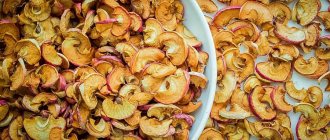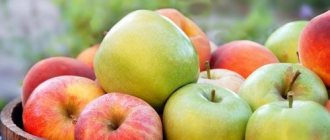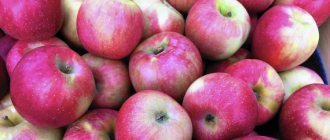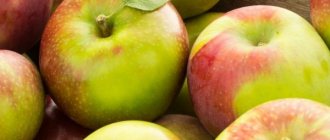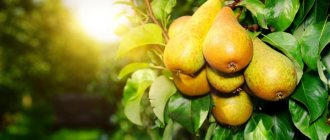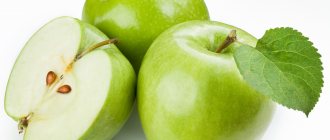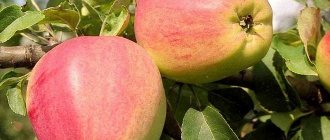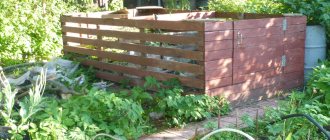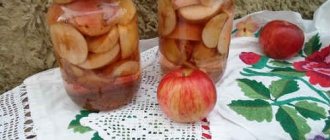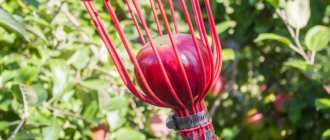Subcutaneous spotting, or bitter pitting
A distinctive feature of the disease is small, 2-3 mm in diameter, depressed greenish spots on the skin, which enlarge during storage and turn dark brown. The apple pulp under the spots becomes spongy, cork-like, and acquires a bitter taste. With severe development of the disease, the plugs penetrate the entire pulp to the core. The main reason for the development of bitter pitting is a lack of calcium in fruits. Favorable conditions for the occurrence of the disease are also created by frequent watering and heavy rains, applying large doses of nitrogen and potassium fertilizers, and storing apples at high temperatures. Due to the strong development of subcutaneous spotting, fruit rot may also occur.
Control measures. For better storage of fruits, spray trees with calcium nitrate solution 4-6 times per season. Carry out the first treatment with a 0.5% solution 3 weeks after flowering, the second (0.8% solution) two weeks after the first, the third and subsequent ones (1% solution) at an interval of 14 days. Foliar feeding can be combined with treatments against diseases and pests. Before storing, immerse the fruits in a 4% calcium chloride solution for 1 minute, and then dry thoroughly.
Bitter pitting: description of the disease.
Bitter pitting is a physiological disease of fruit crops that has become widespread with the intensification of fruit growing.
The disease is undoubtedly associated with calcium imbalance. Too low calcium content in fruits is caused by too little calcium supply and uneven distribution between the organs of the tree. Roots cannot absorb calcium in any quantity. Limited calcium uptake may be caused by too much potassium in the soil and possibly decreased transpiration due to lack of water. Decisive for the appearance of bitter pitting is, apparently, not only the calcium content in the fruit itself, but the ratio of this element to the content of potassium and magnesium in the fruit. Too much potassium and magnesium, even with normal calcium supply, also causes pitting spots. Therefore, it is impossible to apply, first of all, arbitrary amounts of potassium to fruit crops.
It is not difficult to prove by simple experiment that with increasing doses of potassium, the tendency of fruits to bitter pitting increases. Too much nitrogen fertilization can also increase the risk of bitter pitting in fruit crops. Nitrogen is known to stimulate tree growth and leaf production. A large assimilation surface promotes, on the one hand, the growth of the fruit, and on the other, the movement of substances through the sieve tubes, so that the latter predominates more than usual. This hinders the flow of water from xylem tissues into the fruit and, accordingly, the associated supply of calcium to the fruit deteriorates.
This competition between leaves and fruits is even more intense when there is a lack of water. Not only nitrogen, but also all other measures that stimulate the growth of shoots contribute to the development of bitter pitting.
Heavily pruned fruit crops have more fruit affected by bitter pitting than fruit crops that are less pruned or left unpruned. As you know, pruning stimulates shoot growth and this increases competition between leaves and fruits. The stronger the growth of the shoots, the more predominant is the movement of substances through the sieve tubes, as a result of which the supply of calcium to the fruit deteriorates more and more. Since this element is deposited in fruits only for a very short period at the very beginning of their development, its concentration continuously decreases as the fruit grows. Large fruits therefore tend to have relatively lower calcium content and are therefore more prone to bitter pitting than smaller fruits.
Browning of the skin, or tanning
The disease appears on apples several months after storage. Distinctive features: brown specks on the skin, which gradually merge and form spots. The skin remains dry and intact, and the flesh remains juicy. Severe sunburn can contribute to the development of fruit rot.
Control measures. Harvest apples at the optimal time (harvesting too early contributes to sunburn). Cool them quickly after removing. Monitor the air humidity in the cellar. To prevent the development of the disease, each apple can be wrapped in oiled paper.
Bitter pitting: control and prevention measures.
The results of numerous studies of non-parasitic diseases provide valuable guidance for the appropriate pruning of trees and corresponding fruit thinning. To prevent the appearance of fruits with bitter pitting, it is necessary to create a narrow ratio of leaves to fruits in the upper part of the crown, i.e. in places with the strongest growth, so that the fruits are not too large and too loose.
Bitter pitting depends on the total amount of precipitation and its distribution throughout the year. During certain periods of development, fruits react especially strongly to lack of water by forming spots of bitter pitting. Since tillage and mulching of the soil even out its water regime and somewhat counteract the occurrence of physiological diseases of the fruit, mulching with mown grass should also reduce the development of bitter pitting.
However, practice shows that plantings where the soil is kept under mulch are often particularly susceptible to bitter pitting disease. When mulching with grass, very large amounts of nutrients enter the soil. Although some of them are again spent on grass growth, they still have an impact on the nutrition and development of fruit trees. Grass mulch also adds a large amount of humus to the soil. This nutrient substrate is activated due to the activity of soil organisms. Nutrients in poorly soluble forms are converted into accessible forms for plants. The top layer of soil is enriched with nutrients, which leads to their excessive absorption by plants and thereby to undesirable changes in the quality of fruits.
Mulch further contributes to a rapid decrease in soil pH values and an increase in soil acidity. But all these consequences of mulching are taken into account too little in many places, and the doses of fertilizers do not correspond to the changed conditions. Although soil pH values have dropped more or less strongly each year since the transition from grass forage to mulching, fruit growers, with relatively few exceptions, continue to use calcium-free fertilizers.
The appearance of bitter pitting spots can be quite successfully prevented by spraying with preparations containing calcium. Based on many studies, calcium chloride is more effective than calcium nitrate. When sprayed with calcium nitrate, trees receive quite significant amounts of nitrogen and, in particular, at a time when nitrogen adversely affects the quality of the fruit. Therefore, it is better for fruit growers to use the more expensive calcium chloride. Since this product is more effective at preventing bitter pitting, its higher cost is more than offset by improved fruit quality.
To reduce the formation of bitter pitting stains, the following points must be considered.
1. Any one-sided and too abundant fertilizer has a negative effect on shoot growth, productivity and fruit development. Therefore, the dose of fertilizer must necessarily correspond to the needs of the tree. At the same time, you must always remember that trees already receive large amounts of nutrients from mulch throughout the growing season. Considering the negative impact of late application of nitrogen fertilizers on the quality of fruits, it is necessary to look for effective means and ways to reduce the mass of mulch in the summer. Fruit growers often add too much potassium.
The old idea that potassium can be applied to the soil in arbitrarily large quantities without hesitation is incorrect. Such overfertilization with potassium, especially at low soil pH values, favors the leaching of calcium from it. Often the soil reserves of potassium are so large that it would be necessary to temporarily abandon the application of potassium fertilizers altogether.
Another important measure to prevent bitter pitting is regularly providing trees with water. Despite the fact that grass mulch regulates the water regime of the soil, in the second half of the growing season it is necessary to reduce the volume of mowed mass in order to stop the untimely supply of nutrients to the soil. In plantings where the soil is kept under mulch, fertilizers containing calcium should be applied liberally unless the soil pH is above neutral. At a pH below 5.5, liming is required. However, more than 1000 kg/ha of fertilizer lime should not be applied annually. The best way to increase soil pH is by adding burnt lime.
2. By pruning trees, we strive to achieve and maintain a balance between shoot growth and fruiting. However, pruning does not promote the formation of flower buds, but only enhances growth and prevents the rapid deterioration of trees. Very often, fruit growers prune trees too much and thereby excessively enhance their growth. Since shaded fruits are more prone to physiological diseases such as bitter pitting than well-lit fruits, it is very useful to form sparse crowns. Summer pruning provides better illumination of the inner parts of the crown, while simultaneously removing competing branches that negatively affect fruit development.
3. An important condition for the development of healthy fruits is even fruiting. Fruit from lightly loaded trees is usually too large and therefore more susceptible to disease. If the harvest is too large, the fruits, although smaller and healthier, do not meet the high quality requirements. Therefore, by thinning the fruit, pruning and fertilizing, fruit growers should strive to transfer the trees to annual fruiting.
The degree of fruit thinning should correspond to the characteristics of the variety and the vigor of tree growth. The ratio of leaves to fruits on individual fruit-bearing branches is decisive. Too much thinning of fruit on fast-growing parts of the tree can adversely affect the quality of the fruit and its keeping quality.
4. Fruits harvested at optimal times are generally less susceptible to bitter pitting. Since late placement of fruits for storage has a very bad effect on the results, it is necessary to deliver the fruits to storage as quickly as possible after harvesting.
5. A fairly good way to prevent bitter pit disease can be spraying trees with a 0.6% solution of calcium salts (calcium chloride or nitrate). Trees prone to bitter pitting of fruits should be sprayed with this 0.6% solution 4-6 times per season every 10-14 days. In plantings less susceptible to this disease, two or three treatments are sufficient. The last spraying is carried out no later than three weeks before harvesting.
If the treatment was carried out in the evening or in cloudy weather and surfactants were added to the working solution, there are fewer burns on the leaves. The formation of pitting spots is also significantly reduced when fruits are immersed immediately after collection in a calcium chloride solution. However, for technical and sanitary reasons, this method of combating pitting is not yet of great importance in production conditions.
Although spraying with calcium salts is quite effective in preventing bitter pitting of fruits, fruit growers must first create conditions for unimpeded fruit development through appropriate care measures (for example, fertilizers, pruning, thinning of fruits). It would be unreasonable, on the one hand, to contribute to the occurrence of bitter pitting by inappropriate measures, and on the other, to try to eliminate it at great expense.
Penicillosis, or wet rot
The disease can be recognized by soft, watery, light brown spots that emit an unpleasant odor. If such fruits end up in the cellar, over time they will wrinkle, become soft and secrete juice with a musty smell. The fungus that causes penicillosis can develop even at a temperature of 0 degrees, and its spores are easily carried by the wind, infecting healthy fruits and settling on tools, containers, walls and storage shelving.
Control measures. Harvest apples in a timely manner, cool them quickly and store them. Try not to injure the fruits. Maintain optimal temperature and humidity in the cellar. To prevent the development of rot, promptly treat trees against diseases and pests, and also disinfect the cellar and containers before storing fruits.
Fruit rot, or moniliosis
Quite a common disease. Fungal spores enter the fruit in areas damaged by insects, hail, or through cracks caused by scab. First, a small brown spot appears on the apple, which gradually grows. Gray cushions form on the surface of the spot, and the pulp underneath becomes loose and unsuitable for eating. When the disease appears closer to autumn, the fruits acquire a glossy black color, become hard and mummify. If such a diseased apple ends up in storage, at a temperature of +2 degrees and above, fungal spores will begin to infect the remaining fruits.
Control measures. All summer, collect and destroy affected carrion. In autumn, collect not only fruits hanging on the tree, but also those that have fallen to the ground, as well as mummified ones left hanging on the branches. If a monilial burn is detected, cut out and burn all affected branches. Before storing fruits, disinfect the basement (cellar), and carefully inspect each apple.
Maria MAKSIMENKO, Ph.D. agricultural sciences
Bitter pitting: symptoms of the disease.
Large fruits get sick more often than small ones. Bitter pitting appears in the form of small (1.5-3 mm) slightly depressed spots. The color of the spots depends on the affected variety, usually dark red or light green. Over time, the spots become larger and darker. The affected fruit pulp is loose and has a bitter taste.
The apple variety is Grushovka Vernenskaya , the most susceptible to bitter pitting disease, sometimes fruit damage is up to 90%. Also, through observation, varieties were identified that are most often affected by subcutaneous spotting: Baldwin , Auralia , Golden Delicious , Renet Simirenko , Salgirskoye , Stark , Antonovka vulgaris , Pepin orange Cox , Grafinsteinskoye .
The fruits lose their marketable appearance. They acquire a bitter taste, which makes them impossible to eat. Fruit loss due to disease is up to 10%.
How to remove fruits
- Start picking apples from the lower branches of the tree, gradually moving to the upper ones.
- Try to preserve the entire stem. When it breaks, moisture evaporation increases and the fruits wither faster. And when it is removed, the skin is usually damaged, which leads to all kinds of diseases.
- To remove an apple, cup it with your palm from below so that your index or middle finger rests on the place where the stem attaches to the branch. Then, holding the stalk with your fingers and lightly pressing on it with your index finger, turn the fruit upward.
- Under no circumstances should you twist the apple around the stem or pull it downward—this can either damage the stem or break off the overgrown branch.
Raisa MATVEEVA, Ph.D. biol. sciences
Source: Gardener and Gardener magazine
How does bitter pitting appear?
The disease develops against the background of a deficiency or inability to absorb calcium and potassium by the tree. Or their imbalance in the soil. The disease begins to develop on the tree in the garden and appears already during storage. On the fruits of apples or pears, small spots with a greenish tint appear slightly pressed into the pulp. Gradually they spread to the entire surface of the fruit. At the same time, the fruits themselves acquire a bitter taste, and the pulp becomes loose. And the spots are larger, their color changes to rusty-red.
Another reason for the appearance of spots on fruits may be their storage at low temperatures (from zero degrees and below). It is typical that the largest fruits are damaged first.
